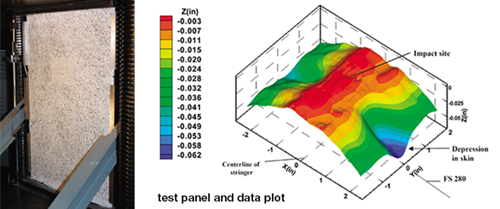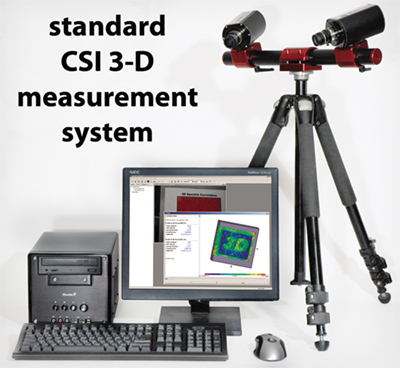Development of a Digital Image Measurement System
Originating Technology/ NASA Contribution
An unexpected tragedy took place on April 28, 1988, when the roof of an Aloha Airlines 737 aircraft ripped open at 24,000 feet, killing a flight attendant and injuring eight people. The in-flight structural failure of Aloha Flight 243’s 19-year-old aircraft prompted NASA Langley Research Center to join with colleagues at the U.S. Federal Aviation Administration and the U.S. Air Force to initiate the Nation’s first Aging Aircraft Research program.
One of the program’s essential goals was to develop reliable, predictive methods for assessing the residual strength of aging aerospace structures. Dr. Charles E. Harris, the NASA director of the Aging Aircraft Research program, realized that the complex distortions and large, three-dimensional (3-D) warping observed in thin, lightweight aerospace structures during the failure process simply could not be measured by existing methods. In response to the need for a new method, Harris provided support to research scientists at the University of South Carolina (USC) from 1992 to 1996 to develop the first method capable of making the required, full-field measurements.
Over the course of this effort, the USC researchers developed Digital Image Correlation, a data analysis process which uses a proprietary mathematical correlation method to analyze digital image data taken while samples are subjected to mechanical stresses. Consecutive image captures taken during the testing phase “show” a change in surface characteristics as the specimen is affected by the mechanical stresses imposed upon it. This type of technology is known as computer vision, the automated extraction of information regarding the objects or scene in one or more images.
The researchers first worked on a two-dimensional (2-D) image correlation method that could be applied to planar specimens that experienced only small out-of-plane displacements during loading. Extending their work on 2-D computer vision, the researchers then developed a 3-D measurement system using stereo-vision principles, in which two images taken simultaneously from two different angles are brought together into one image for 3-D perception. The new system proved to be robust, accurate, and effective in measuring the complete 3-D shape and deformations of thin, warping aerospace structures. In addition to being used for laboratory experiments, the system was portable and effective under field conditions. When deployed on a concrete tarmac, it successfully measured the response of selected sections of a commercial jet fuselage being subjected to internal pressure loading. Upon completion of the initial development phase, the technology continued to be improved and upgraded.
Partnership
In 1999, USC licensed a key component of the technology it developed through the Aging Aircraft Research program. As a result, Correlated Solutions, Inc. (CSI), of West Columbia, South Carolina, was formed to focus on the improvement, development, and marketing of advanced measurement systems using the principles of computer vision. Soon after, CSI received contracts from NASA Langley to build systems capable of making specific measurements of interest to NASA This prompted CSI to convert the working academic system to a viable commercial product.
Product Outcome
While the basic principles employed to develop the original stereo-vision measurement system remain essentially unaltered, CSI has improved and expanded the applicability of all aspects of the technology. It offers both 2-D and 3-D measurement systems. The 2-D digital image correlation system allows for the measurement of full-field, in-plane displacements. The method is easy to use, accurate, and fast. It requires only one camera to take the images and a computer to run the analysis.
CSI’s 3-D system consists of two digital cameras and associated hardware for the cameras to obtain the necessary pairs of stereo images; a computer-based image acquisition and analysis system to record and process the images to obtain full-field data; and software to convert the images into measurements of 3-D displacements. The software, known as VIC-3D, provides a wide array of presentation options for viewing and displaying the data.
The VIC-3D software package offers a user-friendly, Windows®-based environment for image acquisition, camera calibration, image analysis, and data presentation. It has been developed and tested by both CSI engineers and beta-users, resulting in continuous improvements in its effectiveness. Recently, CSI developed and implemented a patent-pending calibration methodology within VIC-3D to ensure that the images can be easily analyzed for maximum measurement accuracy. Based on rigorous mathematical principles, the calibration technology completely eliminates the need for precision translations, precision targets, or precision rotations, resulting in the most robust and efficient calibration process currently available in the imaging industry.
CSI’s 2-D and 3-D measurement systems are available to industry, government, and academia. The company’s marketing representatives in Europe, Asia, and the United States offer custom measurement systems for clients, as well as standard configurations for typical applications. CSI provides full technical support for designing, configuring, and utilizing their measurement systems in virtually any application environment. In support of customer needs, CSI personnel work with each individual to select the appropriate lenses, cameras, lighting, data acquisition hardware, software, and accessories for the application of interest.
The 3-D image correlation technique can be applied to any field requiring an understanding of material deformation when subjected to external influences. Applications include aircraft fuselage and wing analysis, rubber tire analysis, biomedical research, and crash testing. The technology has recently extended its applications to optical stereo-microscopy, scanning electron microscopy, and atomic force microscopy. These new systems allow for the characterization of bio- engineered and nano materials.
Windows® is a registered trademark of Microsoft Corporation.

A typical data analysis from Correlated Solutions, Inc.’s three-dimensional system can be seen in this figure, which shows work on the characterization of advanced materials for the aircraft industry by NASA Langley Research Center’s Don Baker. The picture is of the complete sample and the plot is a local area profile. Image courtesy of Don Baker, “Experimental Results from Stitched Composite, Multi-Bay Fuselage Panels Tested Under Uniaxial Compression”

Correlated Solutions, Inc.’s three-dimensional measurement system utilizes two digital cameras and associated hardware to obtain pairs of stereo images.













